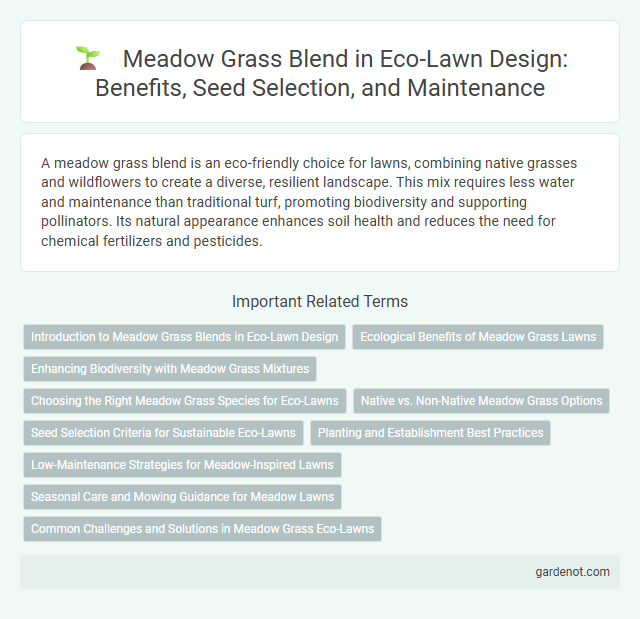A meadow grass blend is an eco-friendly choice for lawns, combining native grasses and wildflowers to create a diverse, resilient landscape. This mix requires less water and maintenance than traditional turf, promoting biodiversity and supporting pollinators. Its natural appearance enhances soil health and reduces the need for chemical fertilizers and pesticides.
Introduction to Meadow Grass Blends in Eco-Lawn Design
Meadow grass blends in eco-lawn design combine native wildflowers and perennial grasses to create biodiverse, low-maintenance lawns that support pollinators and improve soil health. These blends typically include species like red fescue, Kentucky bluegrass, and white clover, which adapt well to varying climates and require less water and fertilizer than traditional turfgrass. Integrating meadow grass blends reduces carbon footprint while enhancing aesthetic appeal and promoting sustainable landscaping practices.
Ecological Benefits of Meadow Grass Lawns
Meadow grass blends support biodiversity by providing habitat and food sources for pollinators such as bees and butterflies, enhancing local ecosystems. These lawns require less water and minimal chemical inputs compared to traditional turfgrass, reducing environmental pollution and conserving natural resources. Their deep root systems improve soil health and promote carbon sequestration, contributing to climate change mitigation.
Enhancing Biodiversity with Meadow Grass Mixtures
Meadow grass blends combine diverse native species to create sustainable, low-maintenance eco-lawns that support local wildlife and pollinators. These mixtures improve soil health by promoting a balanced ecosystem and enhancing nutrient cycling. Incorporating meadow grass blends increases habitat variety, boosting biodiversity and resilience in urban and rural landscapes.
Choosing the Right Meadow Grass Species for Eco-Lawns
Selecting the right meadow grass species for eco-lawns involves prioritizing native and drought-tolerant varieties such as Festuca rubra, Poa pratensis, and Cynosurus cristatus, which support biodiversity and require minimal maintenance. These species enhance soil health by improving aeration and organic matter content, reducing the need for synthetic fertilizers and irrigation. Incorporating a well-balanced meadow grass blend promotes resilient turf that thrives in various climates while providing habitat for pollinators and other beneficial insects.
Native vs. Non-Native Meadow Grass Options
Native meadow grass blends, composed of indigenous species like Little Bluestem and Switchgrass, are optimized for local ecosystems, promoting biodiversity and requiring less water and maintenance. Non-native meadow grass options often include fast-growing varieties that may provide quicker ground cover but can disrupt native habitats and outcompete local flora. Selecting native species supports sustainable landscaping by enhancing soil health and providing habitat for pollinators and wildlife.
Seed Selection Criteria for Sustainable Eco-Lawns
Meadow grass blend for eco-lawns prioritizes seed selection criteria emphasizing drought tolerance, low maintenance, and biodiversity support to ensure environmental sustainability. Native and deep-rooted grass species are chosen to promote soil health, reduce water usage, and enhance habitat for pollinators and beneficial insects. Selecting seeds adapted to local climate conditions minimizes the need for chemical inputs, fostering a resilient and eco-friendly lawn ecosystem.
Planting and Establishment Best Practices
Meadow grass blend thrives best when planted in well-prepared soil with good drainage and full to partial sunlight exposure. To ensure successful establishment, sow seeds evenly at a rate of 1 to 2 pounds per 1,000 square feet and lightly rake the soil to cover the seeds for optimal germination. Regular watering, maintaining soil moisture consistently for the first 3 to 4 weeks, promotes healthy root development and a robust eco-lawn.
Low-Maintenance Strategies for Meadow-Inspired Lawns
Meadow grass blends, featuring native species like fescues and wildflowers, offer low-maintenance strategies ideal for eco-lawn designs by reducing the need for frequent mowing and irrigation. These blends promote biodiversity, improve soil health, and naturally suppress weeds, creating resilient, sustainable lawns. Choosing drought-tolerant varieties within the blend minimizes water consumption and supports long-term ecological balance.
Seasonal Care and Mowing Guidance for Meadow Lawns
Meadow grass blends thrive with seasonal care that includes light fertilization in spring to support early growth and strategic watering during dry periods to maintain health without overhydrating. Regular mowing at a height of 3 to 4 inches encourages deep root development and preserves the natural meadow aesthetic by preventing weed takeover. Avoid frequent mowing in late summer to allow wildflowers to bloom, enhancing biodiversity and creating a sustainable, eco-friendly lawn.
Common Challenges and Solutions in Meadow Grass Eco-Lawns
Meadow grass blends in eco-lawns often face challenges such as uneven growth, weed invasion, and drought sensitivity due to their diverse species mix and natural growth patterns. Implementing adaptive mowing schedules, targeted overseeding, and efficient water management can mitigate these common issues and promote a healthy, resilient meadow grass lawn. Selecting drought-tolerant varieties within the blend and incorporating native wildflowers can further enhance ecosystem balance and reduce maintenance needs.
Meadow grass blend Infographic

 gardenot.com
gardenot.com